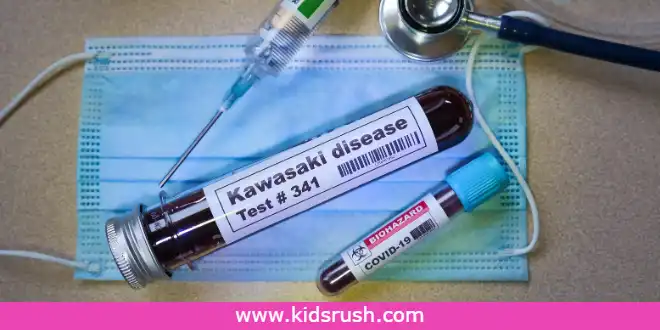The Kawasaki disease can cause inflammation in the blood vessels of the entire body (swelling and redness). This occurs in phases, and the first sign is usually a fever lasting longer than 48 hours. In this article, we will tell you what is Kawasaki disease in children and more… Let’s start
Children with Kawasaki disease usually experience symptom relief within a few days. The ailment mostly affects kids younger than 5 years of age.
Kawasaki Disease in children: What Are Its Symptoms & Signs?
Symptoms and signs of Kawasaki disease come in cycles, which usually begin with a low-grade fever lasting for five days. In this regard we recommend you to read Home remedies to lower fever in children.
Additional symptoms include:
- eyes with a reddish tint
- The symptoms are a pink rash on the back, stomach, arms, genital area, and legs.
- cracked lips that are red, dry, and chapped
- tongues with a “strawberry” texture (white with red bumps)
- a sore throat
- The swollen feet and hands have a purple-red hue to them.
- swollen lymph glands in the neck
Phase two usually begins 2 weeks after the fever begins. Symptoms include:
- peeling skin on the hands and feet
- joint pain
- diarrhea
- vomiting
- belly pain
What kind of problems might arise?
Most children will feel better shortly after starting treatment with Kawasaki disease. Doctors can treat the symptoms if they are discovered early.
A patient’s heart can be severely affected if the diagnosis arrives too late, as follows:
- coronary artery aneurysms (bulges that protrude through the walls of the arteries that supply blood to the heart)
- heart muscle inflammation, valve problems, and the swelling and ulceration of the outer surface of the heart
- heart rhythm disorders, in which there are deviations from the normal frequency and pattern of the heartbeat.
- problems with some heart valves
What is the cause of Kawasaki disease in children?
The cause of Kawasaki disease is unknown. Doctors consider this to be an inherited disorder and do not believe it spreads among individuals. It affects children of Japanese and Korean descent rather than general populations.

What is the diagnosis for Kawasaki Disease?
The symptoms of Kawasaki can look the same as those of several bacterial and viral illnesses among children that are usually diagnosed by asking about the symptoms (such as a long-lasting fever) and performing an examination.
Whenever the doctor thinks Kawasaki disease is likely, he:
- will order tests on your heart, including an echocardiogram.
- can test blood and pee samples to rule out conditions with no confirmed cause, such as scarlet fever, juvenile rheumatoid arthritis, or measles
How Is Kawasaki Disease Treated?
In the course of Kawasaki disease, doctors usually give children’s the following treatments.
- IVIG treatment can help prevent coronary artery aneurysms as well as fight infections. IVIG is given once.
- Aspirin is given to patients through oral administration as a high-dose to treat inflammation. Patients are advised to continue taking aspirin until blood tests have shown reduced inflammation.
Steroids can help prevent coronary aneurysms if doctors give IVIG to some children. For some children, IVIG does not work and they get steroids instead.
Because of the small risk of a rare condition known as Reye syndrome in children who take aspirin during a viral illness, it’s very important for children who’ve been prescribed high doses of aspirin to get the flu vaccine every year.
With immune globulin treatment, most children with Kawasaki disease will get better after a single dose, though there may be a need for further therapies.
Is there anything else I should know?
Kawasaki disease commonly causes complete remission, especially in children when they are diagnosed and treated early on. People with Kawasaki disease who are developing heart problems may need to see a cardiologist. A cardiologist is a doctor trained to assess and treat issues of the heart.
